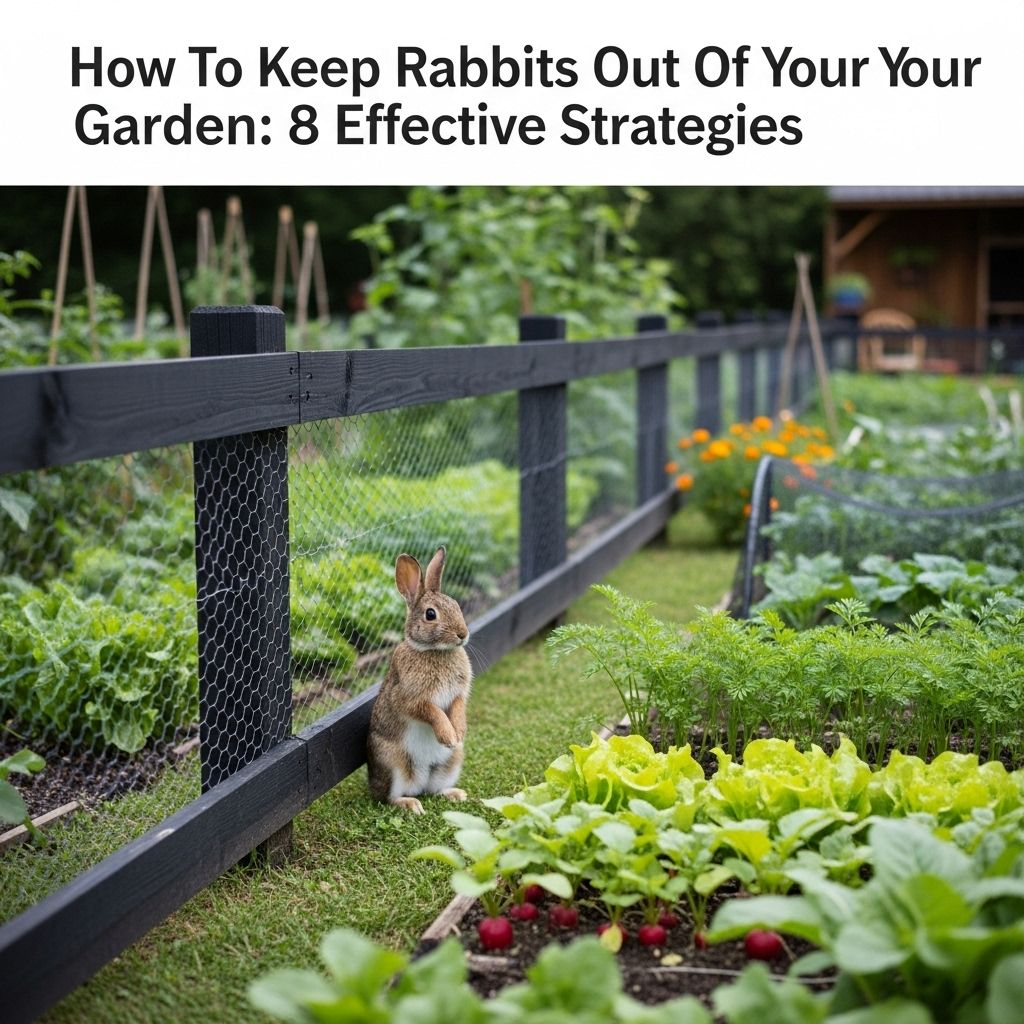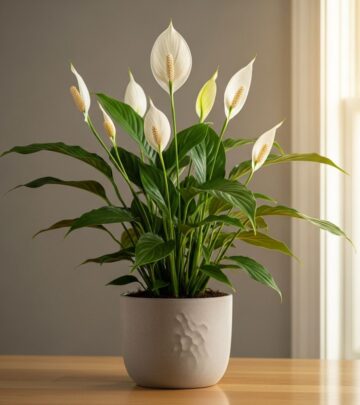How To Keep Rabbits Out Of Your Garden: 8 Effective Strategies
Protect your plants effortlessly with proven tips to deter unwanted furry visitors fast!

Image: HearthJunction Design Team
Effective Strategies for Keeping Rabbits Out of Your Garden
While rabbits might appear adorable with their fluffy tails and twitching noses, gardeners know they can quickly become a nuisance when they decide your carefully cultivated plants make the perfect buffet. These hungry herbivores can devastate gardens overnight, leaving frustrated gardeners wondering how to protect their precious plants without harming the furry visitors. Fortunately, there are numerous humane and effective strategies to keep rabbits at bay while maintaining a beautiful garden landscape.
Understanding Rabbit Behavior in Gardens
Before implementing deterrents, it helps to understand what attracts rabbits to your garden in the first place. Rabbits are looking for three primary things: food, shelter, and safety from predators. Your garden often provides all three, making it an irresistible destination for local bunnies. They particularly enjoy tender young shoots, leafy greens, and vegetables—essentially the same delicious plants you’re trying to grow.
Garden rabbits are most active at dawn and dusk, which means you might not always catch them in the act of nibbling your plants. However, their distinctive damage patterns provide clear evidence of their visits—clean-cut stems at a 45-degree angle about two inches above the ground are the telltale signs of rabbit feeding, as opposed to the jagged tears left by deer or the slime trails accompanying snail damage.
8 Effective Methods to Keep Rabbits Out of Your Garden
1. Install Proper Fencing
The most reliable method to protect your garden from rabbits is installing appropriate fencing. Unlike other deterrents that may work temporarily, a properly installed fence creates a physical barrier that rabbits cannot overcome. When selecting rabbit fencing, remember these essential characteristics:
- Choose chicken wire or hardware cloth with openings no larger than 1 inch (bunnies can squeeze through surprisingly small gaps)
- Ensure the fence is at least 2-3 feet high to prevent jumping
- Bury the bottom portion 6-10 inches underground in an L-shape facing outward to prevent digging
- Make sure gates close securely with no gaps at ground level
For smaller garden areas or raised beds, consider creating removable fence panels that can be lifted for easy garden access during maintenance. The initial investment in quality fencing will pay dividends in protected plants for years to come.
2. Plant Rabbit-Resistant Species
While no plant is completely “rabbit-proof,” many species have characteristics that make them less appealing to hungry bunnies. Plants with strong aromas, tough textures, or mildly toxic properties are typically avoided by rabbits when other food sources are available. Creating a garden filled with these less appetizing options can significantly reduce rabbit damage.
Here are some rabbit-resistant plants to consider incorporating in your landscape:
Rabbit-Resistant Perennials:
- Yarrow (Achillea)
- Columbine (Aquilegia)
- Foxglove (Digitalis)
- Russian Sage (Perovskia)
- Lavender (Lavandula)
- Daffodils (Narcissus)
Rabbit-Resistant Annuals:
- Marigolds (results vary)
- Geraniums
- Snapdragons
- Cleome
Rabbit-Resistant Herbs and Vegetables:
- Basil (especially spicy varieties)
- Rosemary
- Mint
- Garlic
- Hot peppers
- Rhubarb
It’s worth noting that young rabbits may sample plants that mature rabbits avoid, as they haven’t yet learned which plants are unpalatable. As mentioned in The Guide to Humane Critter Control by Theresa Rooney, “Baby bunnies just aren’t smart enough, yet, to know which plants they should eat and which plants they should not.” This means you might need additional protection for new plantings regardless of species.
3. Apply Natural Repellents
Natural repellents utilize scents and tastes that rabbits find unappealing. These can be effective temporary solutions, though they typically require regular reapplication, especially after rain or irrigation. Some gardeners report success with:
- Blood meal (sprinkled around plants)
- Crushed garlic spray
- Hot pepper spray (made with cayenne pepper)
- Predator urine (available commercially)
- Hair clippings (human or pet)
Commercial rabbit repellents are also available and often contain a combination of these natural ingredients in stabilized formulations that may last longer than homemade versions. When using any repellent, always follow package directions carefully, especially on edible crops.
4. Create Habitat Modifications
Making your garden less hospitable to rabbits can discourage them from taking up residence. Focus on eliminating potential nesting areas and hiding spots:
- Remove brush piles and dense undergrowth
- Keep grass trimmed, especially around garden perimeters
- Seal spaces under decks, sheds, and porches
- Clean up fallen fruit and vegetables promptly
Female rabbits seek tall grass and overgrown areas for nesting, where they can have litters of up to 10 babies. By eliminating these potential nursery sites, you discourage rabbit families from establishing themselves in your yard. If you do discover a rabbit nest, contact local wildlife authorities for guidance rather than attempting removal yourself.
5. Employ Visual Deterrents
Visual deterrents capitalize on rabbits’ natural wariness and fear of predators. These options can be particularly effective when moved regularly to prevent rabbits from becoming accustomed to them:
- Reflective objects (like old CDs hung from strings)
- Motion-activated sprinklers
- Owl or hawk decoys (moved frequently)
- Pinwheels and wind chimes (which create unpredictable movement and sound)
For best results, combine visual deterrents with other methods and relocate them periodically to maintain their effectiveness. Rabbits are intelligent and can quickly determine when a “threat” isn’t real if it never moves or changes.
6. Use Physical Barriers for Individual Plants
When protecting specific plants or small groups of vulnerable specimens, individual barriers can provide targeted protection:
- Wire cloches or baskets over young plants
- Plastic mesh cylinders around tree trunks (to prevent bark gnawing in winter)
- Row covers over vegetable beds (ensure edges are secured)
- Plant collars made from plastic containers with bottoms removed
These individual protections are especially useful for newly planted specimens or during the vulnerable seedling stage. Once plants are established and less tender, some may require less protection.
7. Provide Alternative Food Sources
Some gardeners find success with a diversionary approach—planting sacrificial crops specifically for rabbits at the garden’s perimeter. This strategy works on the principle that well-fed rabbits may be less likely to venture into protected garden areas if easier meals are available elsewhere.
Consider planting a “rabbit garden” with favorites like clover, dandelions, plantains, and other rabbit-friendly plants in an area away from your main garden. This approach won’t eliminate rabbit visits but may reduce damage to your prized plants.
8. Encourage Natural Predators
Creating a garden that welcomes the natural predators of rabbits can establish a biological control system. Hawks, owls, foxes, and some snakes help maintain rabbit populations. You can encourage these beneficial predators by:
- Installing owl nesting boxes
- Providing perches for hawks and other raptors
- Avoiding rodenticides (which can harm predators through secondary poisoning)
- Creating brush piles away from garden areas for predator habitat
Remember that encouraging natural predators means creating an ecosystem, which takes time to establish and may have other impacts on your garden experience.
Seasonal Considerations for Rabbit Control
Rabbit problems change with the seasons, requiring adaptable approaches:
Spring
Spring brings breeding season and hungry rabbits emerging from winter. Focus on preventing nesting in your yard and protecting tender new growth with barriers and repellents.
Summer
Summer abundance means rabbits have many food choices. Maintain deterrents around especially valuable plants, but rabbits may naturally diversify their diet with abundant wild food sources.
Fall
As wild food sources diminish, rabbits may return to gardens. Harvest vegetables promptly and protect fall crops with renewed attention to barriers.
Winter
Winter brings the risk of bark gnawing on trees and shrubs when other foods are scarce. Install tree guards before the first freeze and maintain any fencing systems that may be damaged by snow or ice.
Evaluating Effectiveness and Adjusting Strategy
No single rabbit deterrent works perfectly in every situation. The most successful gardeners employ multiple strategies and remain flexible, adjusting their approach based on results. Keep a garden journal noting which methods seem most effective in your specific environment, and be prepared to rotate or combine techniques as rabbits adapt to your deterrents.
Frequently Asked Questions
Q: How can I tell if rabbits or another pest are damaging my garden?
A: Rabbit damage typically appears as clean-cut stems at a 45-degree angle about 2 inches above the ground. You may also notice small, round droppings nearby. Deer leave jagged tears rather than clean cuts, while insect damage usually affects the leaves rather than stems.
Q: Will my dog or cat help keep rabbits away?
A: Pets can help deter rabbits, but only when they’re actively present in the garden area. Most rabbits quickly learn the routines of household pets and will visit when your animals are indoors or in another part of the yard.
Q: Is it legal to trap and relocate rabbits from my property?
A: Laws vary by location. Many states require permits for trapping wildlife, and some prohibit relocation entirely due to disease concerns. Always check local regulations and consult wildlife authorities before attempting to trap rabbits.
Q: Do ultrasonic repellers work for rabbits?
A: Scientific evidence for ultrasonic repellers is limited, with mixed results. Some gardeners report initial success, but rabbits often become habituated to the sound over time, rendering them ineffective.
Q: Will coffee grounds keep rabbits away from my plants?
A: Coffee grounds have a strong odor that may temporarily deter rabbits, but their effectiveness is generally short-lived and requires frequent reapplication, especially after rainfall.
By implementing a combination of these humane deterrents and remaining persistent in your efforts, you can significantly reduce rabbit damage while maintaining a beautiful and productive garden. Remember that complete elimination of rabbit visits may be unrealistic, but with the right strategies, you can protect your most valuable plants while coexisting with local wildlife.
References
Read full bio of Srija Burman












